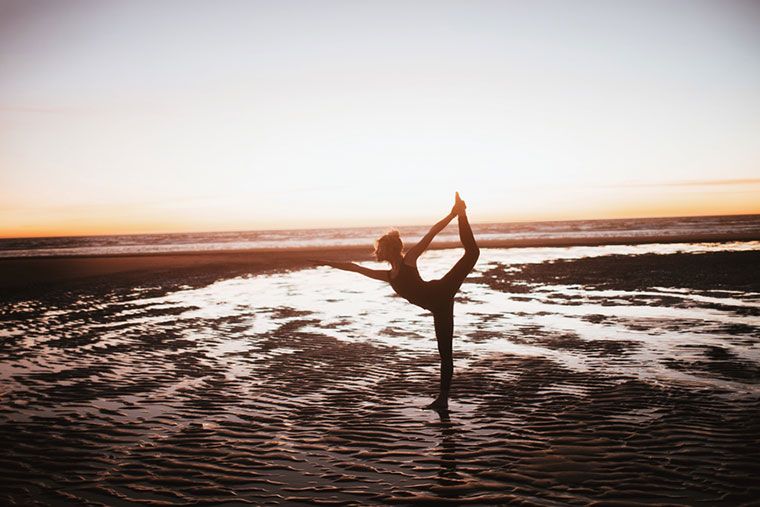It’s all part of a little-known ritual called earthing, which involves making direct contact between your bare feet (or other body parts) and the ground. By getting down and dirty with the grass, soil, or sand, it’s said that you soak up the earth’s negative charge, which reduces inflammation and leaves you feeling more refreshed.
One of the most effective cures for jet lag might be as simple as going outside and kicking off your Vans.
Yes, it sounds totally out-there, but the scientific community agrees that earthing—AKA grounding—has a bunch of legit health benefits. For instance, various studies have proven that the practice helps improve sleep, normalizes stress hormones, improves immune response, and more. (All are super helpful when you’re clocking tons of air miles—or even if you're just living in the modern world.)
Of course, you'd be forgiven for wondering if there's a catch. Like, what do you do if you’re traveling to a city without a green patch in sight? Does the type of ground you’re standing on matter? And how long do you have to ground yourself in order to start reaping the rewards? I turned to a few top wellness pioneers—all self-proclaimed earthing super-fans—to find out.
Read on for everything you need to know about earthing for jet lag.

How does earthing work, exactly?
One of the practice’s most vocal cheerleaders is biohacker and Bulletproof founder Dave Asprey. He actually discovered grounding by accident 12 years ago, during an era when he was making monthly jaunts from California to England.
On one trip, he says, he did a.m. yoga in the park and was jet lag-free for the remainder of his stay. “I was like, 'Yes! Exercise in the morning works [to overcome jet lag],'” he recalls. “But the next time I went, [I exercised indoors] and it didn’t work. The difference is this: When I did yoga in the park, I was barefoot and touching the soil with my hands and my feet. It was only after the research on earthing came out a couple years later that I was able to make that connection.”
Earthing is a way of recharging our cellular batteries.
As he explains in his new book, Head Strong, earthing is a way of recharging our cellular batteries. Essentially, the water in your cells is negatively charged, which allows them to function optimally. But, says Asprey, flying can disrupt this delicate balance, contributing to the low energy that many people attribute to jet lag.

{{post.sponsorText}}
“When you go up in an airplane, you build up a static charge in your body that slows the mitochondrial function,” explains Asprey. “In other words, the battery in your body doesn’t hold a charge as well because you were disconnected from the earth.”
He goes on to say that grounding is one way to dump this static charge and bring your cells back to an energized, negative state. (Which is actually a positive for your bod—confusing, I know.) That’s why Asprey considers it to be a key part of his long-haul travel tool kit. “Your brain works better when your electrical system works better,” he proclaims. And when your brain's working better, jet lag symptoms feel less severe.

How do you work earthing into your travel routine?
According to Asprey, earthing’s easiest to accomplish when you’re traveling somewhere beachy. “Saltwater is highly conductive, so the best grounding you can do is walking barefoot on wet sand or just getting into the sea water,” he says. Same goes for mineral springs and saltwater swimming pools, adds Sarah Livia Szekely Brightwood, president of Mexico's legendary Rancho La Puerta wellness resort. Some people use saltwater float tanks to get the job done, but Asprey says they won’t give you the same benefits (their H2O isn't touching the earth's surface).
You’ll get a similar effect from spending a few minutes on grass, dirt, and even concrete that hasn’t been sealed or painted over. While Brightwood practices earthing every time she takes a sandal-free stroll around the buildings of Rancho La Puerta—its concrete floors are poured directly on the soil and topped with electrically-conducive terracotta tiles—her preferred mode of grounding is digging in her garden (which happens to be Paris Jackson's favorite way to energetically recharge, too). “Putting my hands into the earth brings me deep replenishment, and it doesn't take long,” she says. “My head clears, and I feel completely present.”
Whatever you choose to do, you can maximize the effect by opting for cotton clothing and ditching the rubber-soled shoes. No nature in sight? Asprey recommends buying a grounding mat or pillowcase for your hotel bed, which will give you the same effect.
“Putting my hands into the earth brings me deep replenishment, and it doesn't take long."
In the future, says Asprey, you can expect earthing to become more seamlessly integrated into travel and wellness experiences around the world. It’s already happening at the Bulletproof cafés, which have electrically grounded tables and floors, and at Rancho La Puerta, where guests are encouraged to walk barefoot around the grounds.
“I’ve seen a few exercise machines that are electrically grounded, and there’s a huge opportunity at spas—if you’re getting a massage, you ought to be [on an earthing mat],” Asprey says. “In the future, when you’re building your house, maybe the floor could be electrically grounded. This is futuristic stuff, but step one is acknowledging that this matters to our biology. That’s where we are now. Step two is [building] our world to take advantage of it.”
Until then, at least you've got another excuse to spend more time hanging in the park—without the fear of getting grass stains on your new beige sneakers.
For more travel secrets, find out how Cate Blanchett, Elle Macpherson, and Jennifer Aniston maintain their good health (and knockout skin) while on the road.
Loading More Posts...